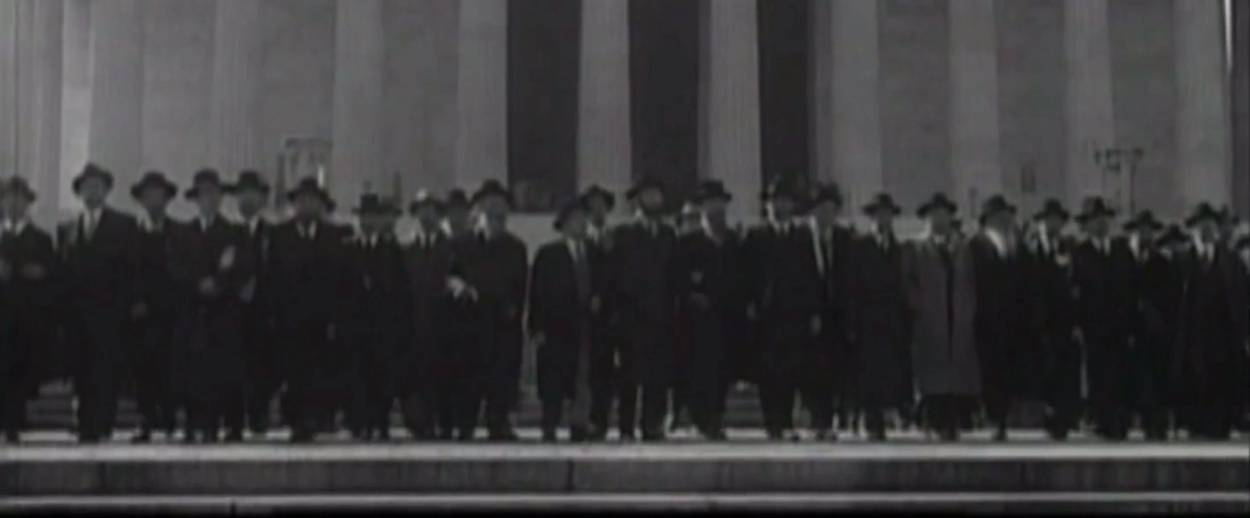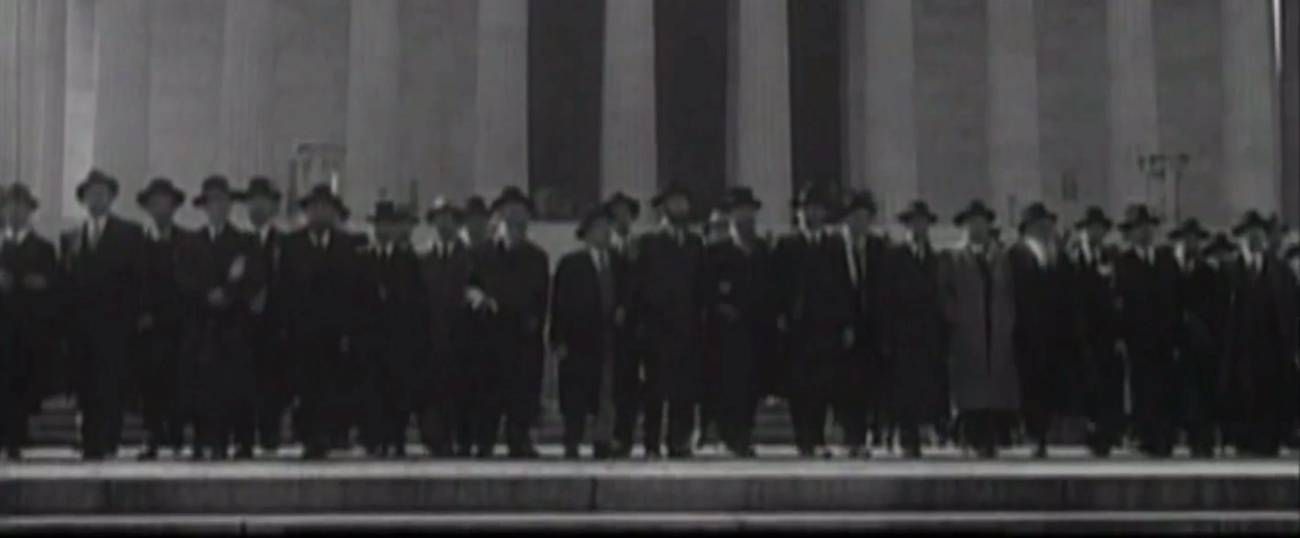The Rabbis Take Washington
When Orthodox rabbis march on Washington, D.C. this week to protest the Iran deal, it won’t be the first time they’ve tried to influence American foreign policy.




As hundreds of Orthodox rabbis plan to gather in Washington, D.C. on Wednesday to lobby against the Iran deal, a fantastic online exhibit recalls another time Orthodox rabbis gathered in the U.S. capital: On October 6, 1943, three days before Yom Kippur, close to 500 Orthodox rabbis demonstrated their support for increased government action to save European Jews during the Holocaust.
The exhibition, titled “The Day The Rabbis Marched,” appears on the website of The David S. Wyman Institute for Holocaust Studies based in Washington, D.C. The text of the exhibit is written by Dr. Rafael Medoff, the director of the institute and Tablet contributor whose academic focus is America’s response to the Holocaust.
The 1943 march was organized by Hillel Kook, the nephew of the former chief rabbi of British Mandate Palestine, Abraham Isaac Kook; Hillel Kook took on the name Peter Bergson for his political activities in America.Bergson’s activism was assertive and unabashedly public, despite not being American himself. In addition to organizing the march, he advertised in newspapers and even commissioned a theatrical performance to alert Americans about Nazi Germany. He was the eventual founder of the Bergson Group, which launched the strongest American effort to save the Jews of Europe.
Prominent American Jews at the time were far less interested in public protest and as a result, writes Medoff, “it was the only rally in Washington on the rescue issue during the entire period of the Holocaust.” Even in its inception, several influential Jews worried that the march would be a source of embarrassment, such as Sol Bloom, a New York Congressman who chaired the House Foreign Affairs Committee and tried to convince the rabbis not to march.
Bloom, a passionate supporter of the creation of a Jewish State who helped write the U.N. charter in 1945, strongly disliked Bergson and publicly discredited his activism by pointing out his alien status in America, and his political idiocy by demonstrating the prohibitive costs of any rescue plan he suggested. And Bloom knew a thing or two about making it as a Jew in America: he was a self-made businessman, raised in poverty and eventually became one of the most famous real estate developers in New York City. According to the Wyman exhibit, Bloom told the rabbis that it would be undignified for them to appear as a group in Washington, looking un-American in their beards and long coats.
Rabbi Stephen Wise, a prominent Reform rabbi at the time, was also against the protesters. Wise, like Bloom, certainly did not shirk from his own Jewish identity. He was a prominent American Zionist leader and a close collaborator with Theodor Herzl himself. Wise also harbored a deep hatred for Bergson. According to the Wyman Institute, Wise called the march an “Orthodox rabbinic parade” run by “stuntists,” and was a “painful and even lamentable exhibition” which threatened the well being of American Jews.
Despite the disapproval from prominent American Jews, the 500 rabbis made it to Washington. They came from all over the country, mainly from the New York and other cities in the Northeast, but some as far as the Midwest traveling from the likes of Chicago and Cleveland.
Although many moderate Orthodox Jewish rabbis made it to the march, the main organization in charge of recruiting the rabbis was Va’ad HaHatzala, whose leaders were Yiddish-speaking Torah scholars who completely avoided involvement in American politics. The Holocaust proved as a rare exception to their isolationist outlook. Writes Medoff:
The rabbis who marched that day included some of the most prominent rabbinical figures in the American Jewish community, such as Eliezer Silver and Israel Rosenberg, co-presidents of the Union of Orthodox Rabbis; Solomon Friedman, president of the Union of Grand Rabbis; Bernard Dov Leventhal, known both as the chief rabbi of Philadelphia and one of the leaders of the Orthodox rabbinate nationwide; and Rabbi Moshe Feinstein, who would later come to be regarded as the leading authority in America on matters of Jewish religious law. The marchers also included an interesting array of hasidic rabbis side by side with rabbis known as mitnagdim, the traditional theological critics of hasidism.
When the rabbis arrived in Washington, they walked from Union Station to the steps of the Capitol building. They were met by various prominent senators and Vice President Henry Wallace, who made a statement that expressed grief over the plight of European Jews, but expressed no interest in changing any policies. Two rabbis read the group’s petition in Hebrew and English, asking President Roosevelt to form a special agency to rescue the remainder of Jews in Europe.
The rabbis chartered cars to the Lincoln Memorial where they prayed for the welfare of the president, America’s soldiers abroad, and European Jews. They finished by singing the national anthem in Hebrew.
After walking to the White House, they discovered their meeting with President Roosevelt had been canceled. Samuel Rosenman, another close Jewish advisor to the president, urged FDR not to meet with the rabbis. Before their arrival, the president exited through the back door of the White House.
Instead, they were met with presidential secretary Marvin McIntryre who told them the president was unavailable.
Related: Three Lies
Rikki Novetsky is TK BIO.